Is It The Seeing of Art, or The Art of Seeing?
FTLComm - Tisdale - December 29, 1999, By: Timothy W. Shire

In the last week of this year and depending on how you count, of the second thousand years of our calendar, we seem to be taking a sort of inventory of what humans are about and what they have accomplished. Magazines and television programmes tell of the top ten performers, politicians, athletes and barbers, so it seems only appropriate to consider what have we achieved in art.
Many people consider the marvels and remarkable achievements of the Renaisance painters as both the starting point for such a discussion and the development of a level of human introspective that let
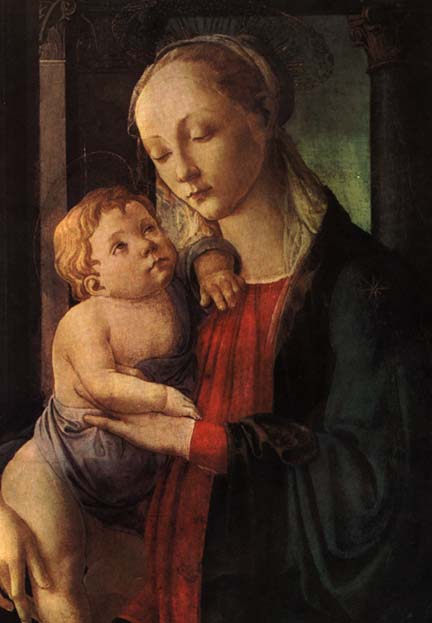 us, as a
species develop a
us, as a
species develop ameans to represent our reality to each other in a graphic form. That is the reason I thought it best to begin this discussion with Leonardo daVinci's (1452-1519) Mona Lisa. I don't really want to talk abou that particular work other then to identify it as a remarkable example of European and Western culture's self awareness in the form of graphic expression. Because of space here many of the images are cropped a bit and in Mona Lisa's case we only see her marvellous face.
But, there is no doubt that in most of our minds the style of presentation and the way we see determines also what we see, therefore Mona is pretty important.
The picture on the right, Madonna and Child by Sandro Botticelli (1445-1510) is pretty much what we have come to appreciate as typical work from the Renaissance. Though many other painters of the era like Michelangelo Buonarroti (1475-1564) are even more dramatic, the theme and treatment of the images is very much established in our minds and it might very well be the base line from which we view all images.
Visual conventions are wholly within our conscious realm, the way we learn to perceive our reality is not prescribed by our eyes and brain but it is
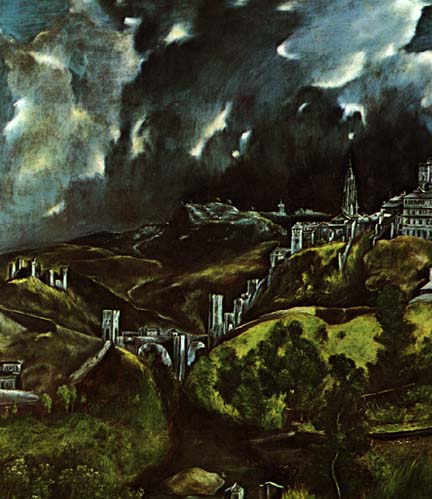 our interpretive
and inquisitive
our interpretive
and inquisitivemind that sets to work and really does the looking. The painting on the right, View of Toledo, by El Greco (1541-1614) could have as easily been created at the beginning of this century as artists placed their intellect into their works as they showed us what they saw rather then depicited what was there in terms of light and image.
A period began where artists at first then about a hundred years later musicians and even later writers, moved from representing reality to glorifying what reality might be. This process has been described by art and music historians as "Romantacism" and it is in this genre that the magnificent British poets we experienced in high school came from, it was the world of composer Richard Wagner and steam rolled through popular culture through to the end of Charles Dickens and perhaps beyond. The Romantic period in the arts is one of the longest running trends that ever occurred and besides spanning such a remarkably long period of time continues to affect art forms today.
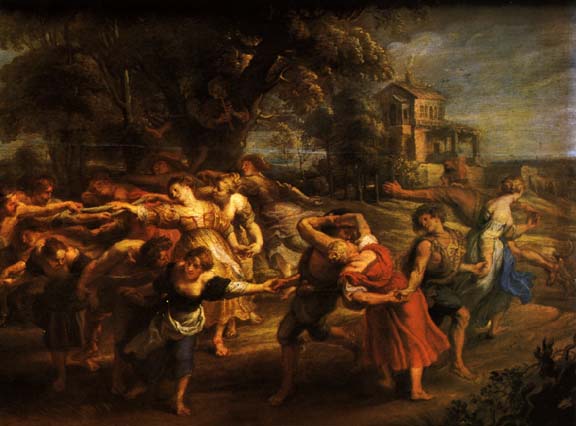
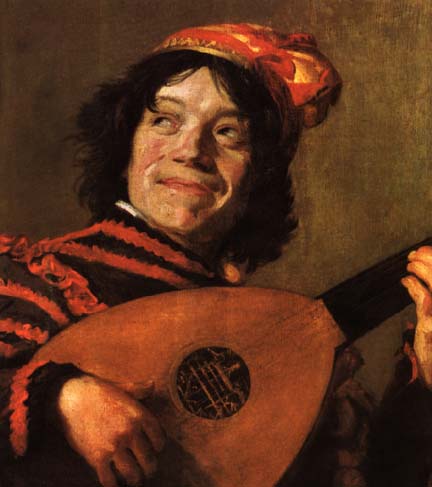
One of the interesting and perhaps one of the ways that the period sustained itself was that with in the Romantic era there was enormous range in expression. This painting, The Jester, by Judith Leyster (1609-1660) a Dutch woman is remarkable as it combines the marvells of the Renaissance with the advancing techniques of the period referred to as the "Dutch Masters". Her work reflects the brilliance of her teacher Frans Hals as she also lets us peek into the character of her subject as she selects a pose and expression that we photographers of this era copy.
Without the technology of today the painters of the past had to rely upon advancing their techniques in capturing light as it tumbles off of objects and more importantly what that light reveals about the people who are portrayed in the images. Leyster is able to grasp the tone of light and the subtlies of shadows which seems to be one of the major accomplishments of the Dutch.
Thomas Gainsborough (1727-1788) is one of the
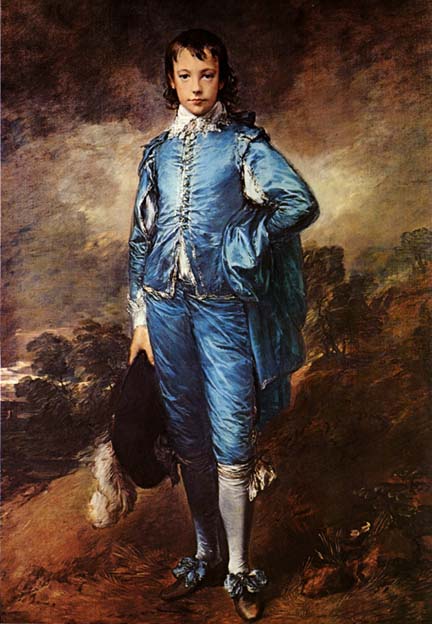 masters
of portraiture and it
masters
of portraiture and itwas his ablility to develop the means to capture the textures of cloth that bring his creations to the continued attention of everyone. Once his style and ability was seen then it became not only a standard to follow but the way people would see and view things in the future.
The Blue Boy is in some ways as well know as Mona Lisa as a definitive means of portraying a person as we now consider not only the peron but the choice of clothing they are seen in and what that means about them.
It is quite likely that the people who lived in the times these paintings were created were as influenced by them as people are today influenced by what they see on television and movies. The image would create not only a representation of what was seen but of the way people would then look at things.
John Constable (1776-1837) was an English painter who has defined the way we look at the sky. Weymouth Bay below is a "romantic" look at the sky and countryside as seen through the eyes of this eighteenth century man. He used water colours directly from the scene so that his impressions of reality were very much the result of experiencing that situation and attempting to capture his feelings and the image at the same time. There is no question that everyone who holds a camera to their eye today is like Constable trying to preserve that scene to share with others or keep it frozen in time for themselves.
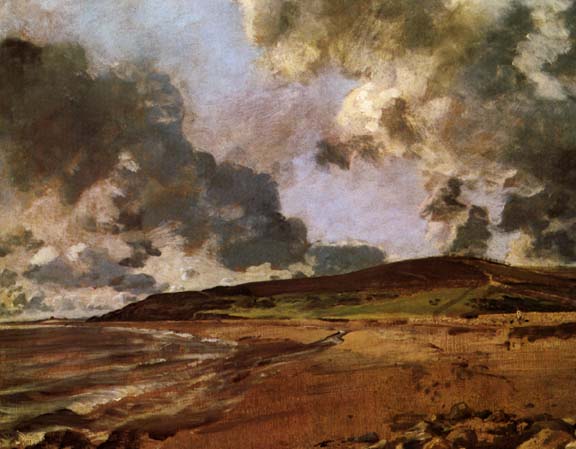
The Snow Storm (below) is the best example of Turner and is a great way for us to see the shift in thinking as Romantacisim remains a strong theme as the new "look" begins to take over. With this shift there is a further shift in the way people think about things. Music follows visual art a few decades behind but when Impressionist music began to emerge it abandoned the dominating melody that is the hallmark of Romantic music as the emphasis shifts to the feel and mood in the music. A few decades later poets and novelist also began to move away fromt he specific and delve into the personal experience of an event, the impression that experience produced.

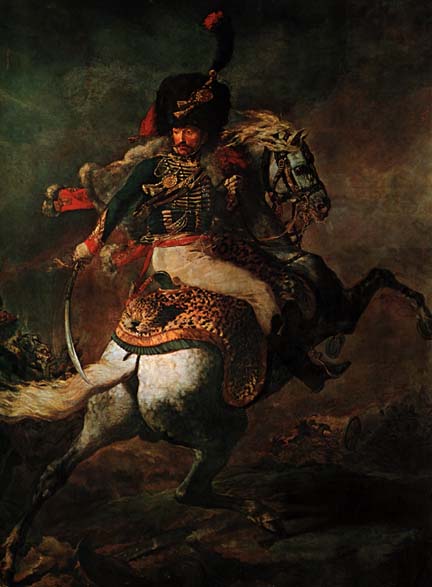
But themes and styles do not go away just because another is coming along. Theodore Gericault (1791-1824) is what the Romantic period is really all about but there is an edge in this work that sees with greater clarity as realism is now defining the event with the event often having a disturbing affect by the exuburance and energy in the scene. Officer of the Imperial Guard was created in 1812 and the painter continued to produce work with war and horses as the central theme, he himself serving in the military and dying in 1824 after falling from a horse.
The nineteenth century was a whirlwind of art as painters competed to produce works that would not only earn them an income but also would identify new techniques and methods to capture reality. The technology of photography was developing as images began to freeze time in levels of gray sometimes on metal, then on glass and finally on paper.
The painter never had anything to fear from photography as it only could capture the light of an image whereas the painter could interpret that light and convey additional meaning and deminsions to the image. Film photographers today share a similar concern with video as it emerges as a means for capturing reality
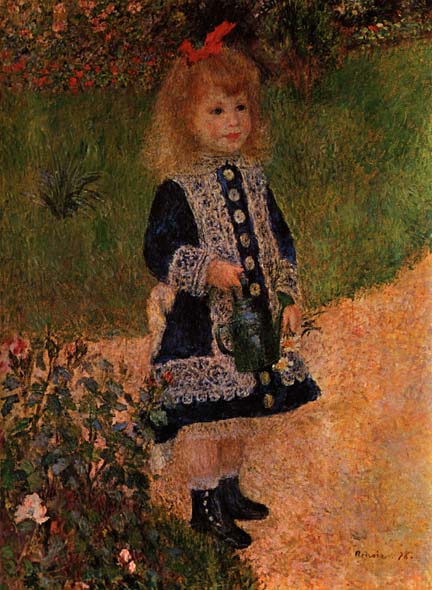 but all of
these forms of media
but all of
these forms of mediaare actually only the tools in the hands of the artists as her or she brings to the scene their view and their interpretation of what is happening.
Pierre Auguste Renoir (1841-1919) is an excellent example of the genre of art referred to as "Impressionalism" though it had begun long before it was in this period that it hit its peak and Girl With Watering Can is an exciting example of both the concept of giving the viewer an "impression" but also of a host of other techniques the created simply and clearly the feel of the image and scene. Renoir, who suffered from arthritis, was able to capture women in his pictures and he did so in such a way that he may be partly responsible for defining feminity. The influence of a painter as outstanding as he is hard to measure but it is certain that others saw his work and added to the style and emphasised those characteristics that he was able to reveal in his images.
Paul Gauguin (1848-1903) is just as important to us as he was a stockbroker who enjoyed his hobby, painting. He left his career and became a full time painter doing impressionist paintings then in 1887 he developed the style for which he is known called "Synthetism" in which he reduces detail, uses black
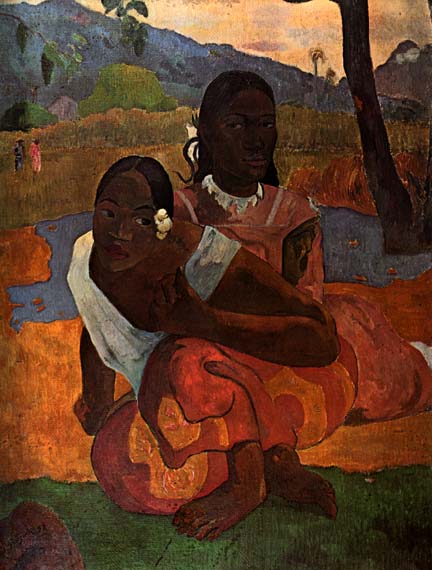 lines to
define shape and fills
lines to
define shape and fillsin with flat colours and by so doing emphasises gesture and is able to convey remarkable emotion in his bright and colourful images.
Gauguin's work was remarkably trend setting in its time as artists of all kinds were seeking to move beyond a mere impression of a subject but wanted more and more to explore the pure intellectual essense of an exerience. This lead to a wide range of experiments as so-called "abstract" painters would seek to convey concept and meaning through shapes and colour and form.
It was this movement which followed the turn of this century and proceeded through much of it as artists abandoned the intrinsic capturing of light and replication of the visual experience in favour of creating visual experiences that would some how and for only some viewers create the feelings and transmit the idea that painter was attempting to portray.
The painter that comes immediately to mind was one of the really few who succeeded in his attempts and that was Pablo Picaso but each of his works are stand alone events and it would not serve him or you well to place one of them here as an example since
Salvador Dali (1904-1999) is one of the most difficult painters of all time to interpret. His work was always exploring the concepts that we all consider important and his images used recognisable forms that we can see while forcing us to determine the meaning at our own level of what that image means to us. The Sacrament of the Last Supper is seen below is perhaps best described as a "surrealist".
But every movie you see, every picture created, must be seen as being a part of human experience and the sort of images that are shown on this page are portions of the work of humans in this Western culture and the present is based on these and many other important works. For simplicity I have only selected a few and have attempted to keep this discussion to basic ideas, but we see things as we have been taught to see them, and they are what we thing they, are based on what our conventions have determined for us. We are an enormously social being and every reality we perceive is based upon its relationship to our social and agreed upon precepts.
